Thursday, May 28, 2009
New Ant Exhibit at Smothsonian The Smithsonian's National Museum of Natural History
Farmers, Warriors, Builders: The Hidden Life of Ants opens this Saturday, May 30th 2009 - October 10th 2009 at the Smithsonian National Museum of Natural History. It's always a real treat to see ant exhibits at museums so make plans and go see it while you can. I believe they will have a colony of leaf cutter ants on display.
Tuesday, May 26, 2009
Short Film: Humble Bumble Death
This is a short clay-animation I did for a college animation course.
Sunday, May 24, 2009
Nectarine Tree now with more Nectarines

I thought I'd update everyone on my Nectarine Tree. There must be close to 100 fruits developing now on there. I don't know if this is healthy though for an 8 foot tall tree. I have been removing some of the smaller ones that were late to develop too; I'm assuming those were the ones with less pollination. I won't know for sure how much fruit I'm getting off the tree until after June. As with all fruit trees the fruits will develop even if they weren't pollinated at all. However, come June, the ones that had little if any pollination will stop growing and fall off the tree. It's called a June drop.
From earlier posts about this tree you might recall there were tent caterpillars on it. Well roughly a week after that post they all up and vanished. Over all damage to the tree I would estimate to be less than 5% of the leaves. And it's filled in completely now. The nibbled leaves are still on the tree but you have to really look hard to find them now.
Unlike other fruit trees I have, this one seems to be free of aphids. Ants still run all around it. Mostly Formica, Crematogaster, and Tapinoma. They're most likely the reason why I no longer have any tent caterpillars on the tree too along with predatory wasps. Currently I think they're licking the small amount of sap that forms as the tree produces new leaves.
Friday, May 22, 2009
Ant War!

Something happening all over the country right are territorial battles by ants. In this case Tetramorium caespitum, The Pavement Ant. Most ants actually get along fairly well with one another. I've actually found this species nesting happily between Lasius claviger and Camponotus castaneus. See here. But when it comes to other colonies of T. caespitum they declair war!
The two colonies send as many workers as they can and a big mass of ants meets in the middle. Despite so many ants involved there seems to be relatively few casualties. For the most part a lot of the ants bump heads and scurry around the mob. A certain few however are ganged up on and torn limb from limb.

Usually the weaker colony isn't destroyed unless it's significantly smaller. The victorious colony gains more territory for their workers to scavenge for food. Despite the fact that other species of ants, sometimes much larger colonies, are nesting in that territory.

Unfortunately I've never been able to devote a lot of time to observing this sort of thing. I'd love to see two colonies going at it and monitor them over the course of the day. One observation I've noticed was these wars only seem to happen during the day. Perhaps they're just harder to find at night?
Thursday, May 21, 2009
Coreopsis
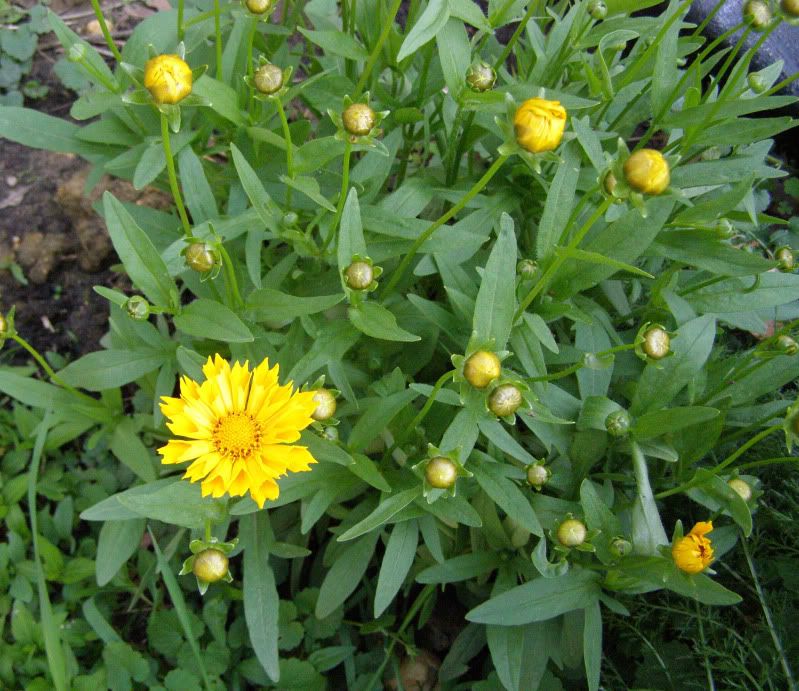
Behold! The first flower in my wildflower garden. Coreopsis 'Jethro Tull' is a cultivator of our native Coreopsis. It also has the common name of Tickseed for some reason. Four more flowers have opened up and tiny sweat bees and common flies are already showing up. To the side of the plant is our goldfish pond and should make for some excelent photos. The dark background of the water and the bright color of the flowers will make for a perfect setting. Now all I need are some insects.
Wednesday, May 20, 2009
Aphids the Overrated Pest

Behold, Aphids and all of their evil. Here we see them sucking the life force out of flower buds to some of the most heavenly smelling roses ever. While many gardeners will be quick to get the insecticide, leaving them there also has it's benefits.
When it comes to roses aphids can prevent the buds from flowering. Thankfully most plants produce way more flowers than they actually need. If you are angered at the fact you have aphids on your plants though now would be the time to act. Simply remove them with a cloth and go after the winged forms as much as possible. Stopping them now will help slow their communicative reproduction.

Another tricky issue is the presence of ants. Yes they are protecting the aphids which are harming the plant. But the aphids are only on the new growth which usually isn't very much of the plant for a given season. Some species of ants are actually providing a service to the plant by guarding the aphids. The older growth maybe free of aphids but not herbaceous insects. The presence of ants can help discourage grazing by such bugs, or at the very least the ants will be removing the eggs to these insects from the plant.

Even when ants are not around to protect the aphids they are still in danger. Here you see flower buds to a native honeysuckle loaded with aphids. But on the other side of the leaf are some ladybug eggs. When the eggs hatch the resulting grubs will feast on the aphids.

Even when ants are protecting the aphids they are not necessarily out of harm. Right under the leaf is a hoverfly larva. These are predators of aphids that somehow go undetected by the ants. In this case I believe the hoverfly larva was producing nectar itself from consuming all the sweet aphids. When the hoverfly reaches adulthood it turns into a colorful fly. Some mimic bees but all the same they're a beneficial pollinator.
These ants weren't doing a particularly good job of protecting them either. Not in the photo is a ladybug feasting on the aphids right next to some ants. And also under a leaf is another clutch of ladybug eggs.
In conclusion aphids never really pose any threat to the plant and the problem will usually fix itself.
Tuesday, May 19, 2009
The Ant Chat Room
I've just gone over to Meebo and designed a chat room. It's there to your right. I figured this might help make the blog more usable. I know I check it every day, usually in the afternoon. Usually 10 people visit regularly and that number has slowly been going up. We'll see how this works out, I might change it to the bottom of the page though or get rid of it entirely. Enjoy for now though.
Monday, May 18, 2009
Ant Chat 12 Ants Mating and Colonies Moving
Just to make something clear, while editing this show the monitor in Adobe Premiere crash or something. Anyhow it wouldn't let me view changes I was making to the show. Thankfully this happened after I deleted a hefty portion of the show that didn't fit in well with everything else. However, it prevented me from fixing certain things like spelling and at one part a photo shows up over another photo. I think it's one of the better episodes I've done all the same but I wasn't about to start over just because of technical issues. So again, I am sorry.
Pheidole Digging

Pheidole are some of the neatest ants around. Their common name is Big Headed Ant because, despite their very small size, they have a major caste with a significantly developed head. This is mostly used for crushing seeds open, though I think a few species have a few other uses for them. Otherwise majors are just used for food storage.

These are the ants I hear everybody say they want. But they often forget how small they are. There are also 625 species world wide, according to "Pheidole of the New World." world wide. And if I count correctly 81 of these occur in North America, according to "Ants of North America." Though I can't speak for every species I can say the few that I encounter are about 2mm long. And for most of those the major caste isn't much bigger.
Friday, May 15, 2009
Camponotus subbarbatus
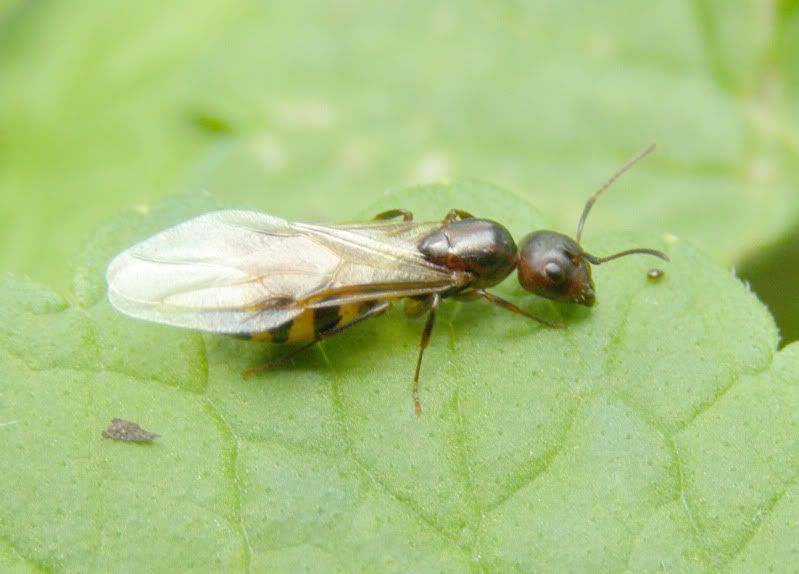
Camponotus subbarbatus started flying today. They seem to fly in the late morning and mid afternoon. Today was ungodly humid, partly windy, and it had rained all last night. Though one of the smaller Camponotus, in the Myrmentoma subgroup, it is one of the prettiest ants around. Normally the smaller Camponotus are all black, polymorphic, species that act like any ordinary Lasius would. All the Camponotus in this group, that I'm aware of, have small colonies of maybe 3,000 ants at most. Most of these are easy to over look, but this has a brightly colored banded abdomen.

Unlike the major pest species of Carpenter Ants, Camponotus pennsylvanicus, C. modoc, etc... these ants are barely noticeable. I've had colonies living in my home before but a whole colony can live happily in a small block of wood. Not exactly a lot of structural damage.
Tuesday, May 12, 2009
Milkweed

Asclepias, Milkweed, is a wonderful prairie plant. Early on it sure doesn't look like much but with following years it earns itself a place in any full sun garden.
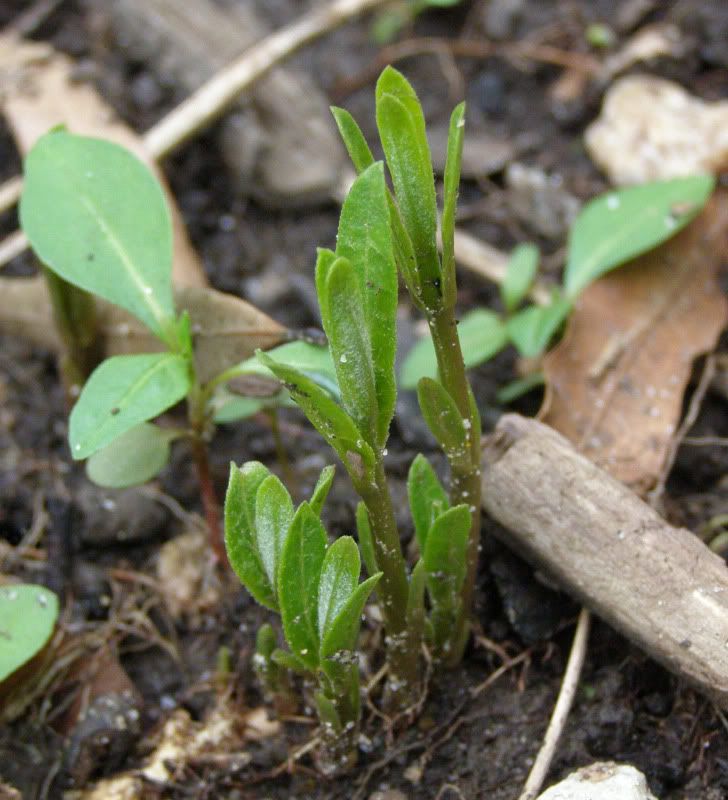
Milkweeds don't flower until their second year. Plants don't emerge until a bit later that you might expect; late April or May. There are more stems and they're thicker this time around. As plants grow older they produce a few more shoots.

This is the primary host plant for the Monarch Butterfly, Danaus plexippus. They have a high success rate too compared with most host plants. If you have 3 to 5 milkweeds growing in the same spot in your garden you're almost garenteed to have caterpillars. The Tussock Moth also uses milkweed as it's host plant but is more common on older plants. In both cases I believe late summer is the time to see them.
Several other species also eat milkweeds but these are the most common.
Even with all these caterpillars nibbling on the leaves they rarely defoliate the plant into an unsightly nub. Leaves are eaten selectively and most caterpillars don't even eat whole leaves until they're 3 weeks old.
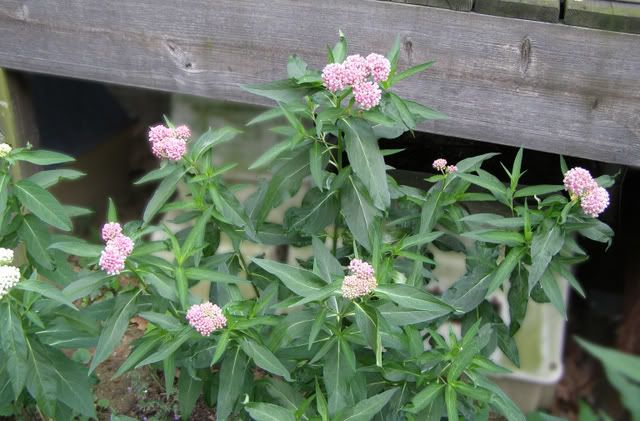
When milkweed's flower they very pretty. Asclepias incarnata, photoed above, has a nice candycain look going for it. Older plants produce lots more blooms. This species is also found in full white too. This species gets 3 to 5 feet tall.
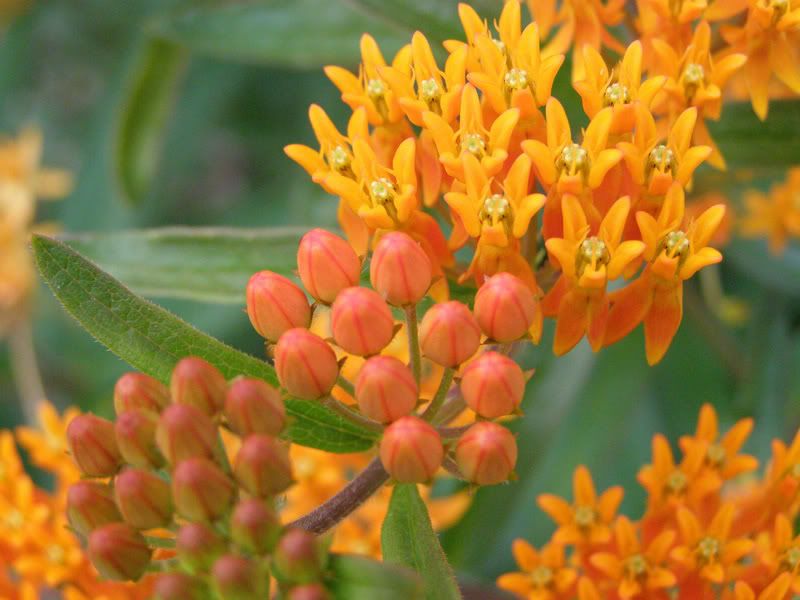
Asclepias tuberosa has a very intense orange color. It's shorter than A. incarnata and tends to flower a bit more. Some varieties are offered in yellow, and red.
When buying these at the store you're likely to see a butterfly on the plant. And sure enough butterflies feed at the flowers, and as I've said, a few use them as their host plant. But what they don't tell you is that Bees Love Them! Lots and lots of bees come to the flowers from the time they bloom to the time they stop flowering.

After flowering the plant will go to seed. Seed pods sprout up and being to crack open releasing their seeds into the air. This is where another insect or two comes into play. Seed Beetles soon arrive, though not always and begin consuming the seeds form the inside out. This is also a reason to buy more than just one plant! The particular beetle here doesn't use pheromones, instead they all just meet up at milkweed plants. So if you have a single plant it might become mobbed with brightly colored, very noticeable beetles. The other pest with these plants is an orange aphid on the plant stem. However, they only show up after it's flowered and don't seem to effect the plants to much.
Monday, May 11, 2009
Honey Bees!

Behold! The queen honey bee. She's the big one in the middle. (Note this is not my finger in the photo.) Unlike ants, bumblebees, wasps, and other Hymenoptera, honeybees prepare for their children's future. They build a nest for them and then the parent queen leaves with some workers to do so again. This usually takes place in the spring and early summer but in souther states this can be a year long event as it is in the tropics. Hives can swarm upwards of 5 times a year, but mostly it's only done once. They otherwise swarm when needed.

Also in the nest are drones, male honey bees, seen here. They're the slightly bigger ones among the workers. Despite their parent hive, drone bees will fly to and from any hive they like. They march right past guard bees and are only removed if the hive is in lack of food. During the winter they're casted out by the thousands to die horribly. For the rest of the year though drones can make up about 1/10th of the hive. They contribute nothing other than ensuring new queens are mated with as they become available. Mating takes place within 5 days of the new queen hatching and is done in the air.

Before swarming the queen of the hive makes sure there are plenty of replacements. Special queen cells are made for her to lay eggs in. These are usually under the frames in the standard beehive used today. They can actually occur anywhere on the frame but off to the sides or under them are the most common. (There is also the issue of supersedure that I'm not going to get into.) Weather allowing, the old queen should be up and out of the hive with roughly 60% of the bees before any of those queen cells open. Otherwise, the old queen will remain in the hive and leave at the next convenience. When it comes to queens, mothers and daughters get alone great. It's sisters that do battle.

Swarming happens in the morning or close to noon. Often the bees don't know where they're going yet so they land on a tree or shrub nearby. Some of you might be seeing a lot of these around this time of year. Should a swarm of bees land in your yard, don't panic! Contact your county office or the police, and tell them you have a swarm of bees and you'd like someone to come take care of it. There's usually a good group of people who do beekeeping as a hobby/small business around. Note that they will only collect swarms of honey bees, they're not exterminators, so don't call them for wasps, or hornets, it's annoying.
Some people do this for free, though it is customary to pay for gas. Others "charge" money for this service. Let me make this clear. If you're in the norther US or any area that experiences winter, then the bees can only establish if they are inside of a structure. The hollow part of a dead tree is ideal. Down south where it stays fairly warm all year even in the winter is the ONLY time when you have hives make their nests out in the open. That means if you're in an area that experiences cold winters a hanging swarm on a tree, bush, or the side of your house, etc... is very likely going to fly somewhere else within 24 hours. However, if they've moved into the walls to your house, shed, or any standing structure it's well worth it to pay now to get them out of there. Read on to learn why.

Swarms are amazing. When it comes to nest building they can fill out a box of 10 frames in less than a month. In the photo above you can see under the bees they've started to draw out the comb, and build cells. To put this in perspective that's like building a 12 inch wide hive 10 feet long. Imagen that in the walls to your home, and that's just the first month. Nest building does slow down after that but that doesn't change the fact that they're in your walls. Hives inside of our homes are real fire hazards. The melting wax over the summer can drip down and get all over electrical work. Worst of all, a weak hive of bees or one that dies off get all manner of pest feeding on the wax, and honey. Wax moths, roaches, ants, assorted beetles will be drawn to the walls of your home. Yes they are clearing out the nest for you but they're also inside your home. For the most part though they're not doing anything bad but the threat of electrical fire should be taken seriously.
It is the roll of the beekeeper to prevent swarms. Mostly by managing splits and combining weak hives together as needed. This will maximize honey yields. But the beekeeper can't do everything they want to. Weather conditions may prevent them from opening their hives, and other things such as a busy day job can also get in the way. Local beekeepers shouldn't be blamed totally though for swarms of bees. There are plenty of feral hives (wild) around nesting in places. Abandoned homes and hollow trees are idea places for them to nest.
A few odd things about Swarms
1) They don't always have a queen. Problems occur and the queen might have had something go wrong. A damaged wing, or reluctance to leave the hive among other reasons can cause the workers to leave without her. So swarms of bees occasionally try to start a new nest without a reproductive. Oops.
2) Swarms can sometimes have two or more queens. In hives with massive population issues often leave the newly emerging queens with to many sisters to kill. Sure a young queen is supposed to hatch out and take control over the hive. But hives that have over population will have made to many queen cells and often several young queens hatch out with the same idea. Swarm again. Sometimes their mother will not have swarmed out yet. This means multiple queens can be in a swarm and in a new hive for a year or so. It's more common than you think. Queens that are sisters will fight to the death eventually. But that doesn't stop the fact that the mother and daughter queen are still laying eggs in the same hive. Both will swarm next spring if not sooner.
Sunday, May 10, 2009
Friday, May 8, 2009
Plants I Bought Today
Despite my garden lacking any room whatsoever, I still somehow justified going to the garden center (not Home-depot or Lowes) and buying plants. It started simply enough. I saw an aquatic plant that looked beautiful! It was a Canna x Orange Aqua which is to be put in your pond. So that's fine, I don't have much in the pond right now besides lily pads. And assuming this plant is invasive it certainly isn't escaping captivity here. I bought a small pond kit at Lowes. So that's fine. Looks pretty, can't wait to see if anything pollinates it.
So then I realized I don't have anything that really blooms in May. And this got me looking around somemore. Mother's day is tomorrow, I already bought her two flats of impatiants to do whatever with. Despite the store filled with plants I said to myself "What could I possably buy here?" and especially with my standards, and love of native plants.
Well apparently I found a lot. Gardening is addictive. This particular gardencenter is awsome! Hereloom tomatoes, Assorted Viburnums, loads of tree, hanging plants all over the place, and it's all setup to be a sheer color overload! And in all this I was able to find a couple of native plants I don't have.
False Indigo, Baptisia australis, was the first one I came across. It hasn't started flowering yet but it's up and growing strong and has some flower buds on it too. I'm eagerly awaiting to see what pollinators like it.
Coreopsis x Jethro Tull, I have no idea what species this is, but the cultivar is "Jethro Tull." Coreopsis is something I commonly find in Wildflower mixes but beyond the first year I've never had them establish. I believe this is a perennial (lives for 3 years) and they even recommend to divide it. Should be flowering by June.
Tennessee Coneflower, specifically Echinacea 'Rocky Top Hybrid,' looked like fun. I have some Coneflowers already and love them. The label says Attracts Butterflies. To be honest though I have never seen a butterfly on one. Even bees are something of a rare site on them. They have their good and bad years I think. On years when the pollinators love them though the Gold Finches will love the seeds. Otherwise though they don't produce well. Won't flower until June/July.
Black-Eyed Susan, Rudbeckia speciosa var. sullivantii Goldstrum' is another native I already own. I bought this one so I could line our steps with them. They're loved by bees. It's a butterfly host plant to a couple of butterflies too, but I've never had them on my plants. Phyciodes tharos, Chlosyne nycteis and Synchlora aerata are some of the pretty ones mentioned in Doug Tallamy's book, "Bringing Nature Home." Which in my opinion is the book that is going to change how gardening is conducted over the next century.
So then I realized I don't have anything that really blooms in May. And this got me looking around somemore. Mother's day is tomorrow, I already bought her two flats of impatiants to do whatever with. Despite the store filled with plants I said to myself "What could I possably buy here?" and especially with my standards, and love of native plants.
Well apparently I found a lot. Gardening is addictive. This particular gardencenter is awsome! Hereloom tomatoes, Assorted Viburnums, loads of tree, hanging plants all over the place, and it's all setup to be a sheer color overload! And in all this I was able to find a couple of native plants I don't have.
False Indigo, Baptisia australis, was the first one I came across. It hasn't started flowering yet but it's up and growing strong and has some flower buds on it too. I'm eagerly awaiting to see what pollinators like it.
Coreopsis x Jethro Tull, I have no idea what species this is, but the cultivar is "Jethro Tull." Coreopsis is something I commonly find in Wildflower mixes but beyond the first year I've never had them establish. I believe this is a perennial (lives for 3 years) and they even recommend to divide it. Should be flowering by June.
Tennessee Coneflower, specifically Echinacea 'Rocky Top Hybrid,' looked like fun. I have some Coneflowers already and love them. The label says Attracts Butterflies. To be honest though I have never seen a butterfly on one. Even bees are something of a rare site on them. They have their good and bad years I think. On years when the pollinators love them though the Gold Finches will love the seeds. Otherwise though they don't produce well. Won't flower until June/July.
Black-Eyed Susan, Rudbeckia speciosa var. sullivantii Goldstrum' is another native I already own. I bought this one so I could line our steps with them. They're loved by bees. It's a butterfly host plant to a couple of butterflies too, but I've never had them on my plants. Phyciodes tharos, Chlosyne nycteis and Synchlora aerata are some of the pretty ones mentioned in Doug Tallamy's book, "Bringing Nature Home." Which in my opinion is the book that is going to change how gardening is conducted over the next century.
Thursday, May 7, 2009
Growing Trilliums

Trilliums are a quintessential spring time woodland flower. Despite being sold in the late winter by some garden stores I have to say planting them in fall is a bit more effective. Regardless though, these are another Rhizome plant which can survive underground and produce no green growth for the first year of development. After being moved or recently planted too, they may also take a season or even a year to adjust. Moving plants is best done in August or whenever they go dormant for the year. They should NEVER be dug up from the wild unless that land is being demolished for "development."
I suppose though it would be fine to simply take one and bring it back to the garden, but that's it! Don't tell anyone where you go them, Don't sell them unless they're extras coming up on your own property! As you will read these plants take an outragious amount of patiants to grow.
Starting them from seeds is the environmental way to do it. Roughly 8 to 10 weeks after flowering the plant will produce a berry filled with seeds inside of it. These are covered with Eliasome, a tasty substance that ants find irresistible. Once the berry turns soft it's safe to pick off the Trillium in question. Miss it though, and the berry will fall to the ground for the ants to have. Ants of the right size compared with the seed will haul the seed back to the nest and essentially plant it, prevent it from being eaten by birds or insects. If the ants are to small though they may simply eat the Eliasome off the seed and abandon it there. Seeds need to be brown in order to be good, so don't pick the berry to soon.
There are lots of reasons why these plants are rare. First off they're monofloral. This means if anything happens to the flower they won't produce a new one for another one to two years. So Don't Pick Them! Second is the ant thing. If there are tomany small ants around they won't spread well. Of course a gardener can help this process along by collecting the seeds and planting them in the ground. Once in the ground they won't really "germinate" for another year, and even then it will only be a blade of grass. These young Trilliums might be mistaken for a weed so be careful. The next year after that will be a simple leaf sticking out of the ground. The next year after that will be 3 leaves as seen here. From here they will flower in 1 to 3 years. From then on they'll flower every year unless moved.
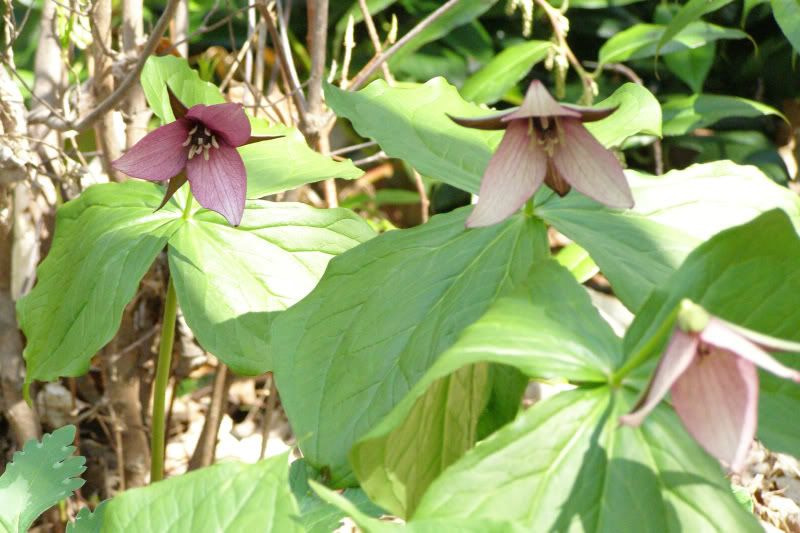
Now you may think this is to much to put up with. No flowers for 3 to 5 years, that's to much to put up with.Well the good news is most rhizomes will grow and spread as adult plants form their location. That is the rhizome to the parent plant continues to grow and spread as the older parts of it die off. That means new plants will simply emerge around the established one, as seen in the image below.
.

So once you have a couple of these plants going they'll continue to spread and grow around slowly, as long as the soil is nice. They prever semi sandy soil with organic matter in it. When dormant they still need to be watered, remember the rhizome is still alive underground. Also DON'T fertalize! This will kill them.
Wednesday, May 6, 2009
Liatris
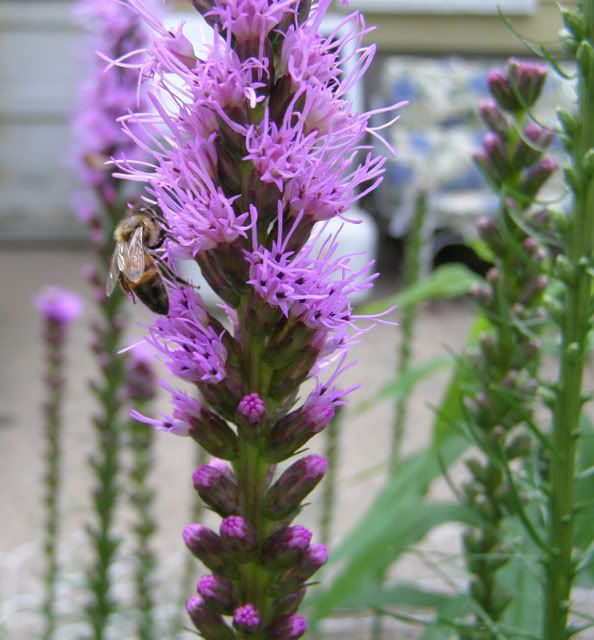
Liatris is a very common wildflower being sold in America. It's also one of the few native plants we find here. Also called Gay Feather, and Blazing Star, Liatris is an easy to grow plant. You can usually buy a bag of them at Home Depot, Lowes, or any garden center really. Plants already growing or special varieties will cost a bit more. The plant itself seems to be a Rhizome. That is the seed grows the first year and developes into a small potato like root underground. That means little if any green growth the first year and blooming is completely out of the question.
Second year though you'll get more green growth and the plant will bloom. That means the plant is biannual. So after two years it dies. However, it is a native plant and does a good job of reseeding itself. So next year you won't notice any plants becasue all the seeds are developing rhizomes in the soil. But the year after that they'll all grow up and start to bloom. Bareing all this in mind the only way to really get them coming back year after year is to buy another packet next year and plant in the same location.
Pollinators absolutely love this plant. And I have tons of them coming up in the yard. Don't worry about the plant getting out of control. Anywhere that the lawn mower is running will greatly effect what can grow there. And also this plant is only noticable every other year unless you've planted two years in a row. Goldfinches will eat the seeds from these plants too, though sunflowers are a clear favorit.
Tuesday, May 5, 2009
Sunflower Planting

Sunflowers are probably the easiest and most commonly available native plant in North America. This year I'm once again participating in The Great Sunflower Project and I've just planted the seeds they sent. Of course I'm not one do anything simple, so along with the annual variety of Lemon Queen they sent, I've also planted a few others. "Annual variety" is in bold because there's also a perennial variety that turns more into a bush.
Mammoth Sunflowers are the tallest variety I've planted. The seed packet says it gets 12 feet tall, online sources say 8 to 10 feet tall, from experience though I can say 6 to 8 feet is more accurate. That's not to say they don't get 12 feet tall somewhere but I've never had it happen here. These were planted in the back. The seeds are edible too! Not just by gold finches, you can eat the seeds. Any sunflower that has white stripes on the seeds are meant for eating. The smaller black seeds are meant for oil production but birds love them all the same. You get a lot of seeds in these packets.
Great American Giant Hybrid is the second one planted. The seed packet says 8 feet tall but online sources tell me 16 feet. I grew these last year and they were about 6. I planted these infront of the Mammoth Sunflowers but did so in a fan effect, not a row. This way if they do get big they're not blocking the view of the other variety behind them. Not a whole lot of seeds in this packet but still enough to plant a bunch.
Lemon Queen was the last variety of sunflowers and went right in the front. This will make them easy to see for the study and I have a nice big oak tree to plant a chair and watch. They get 5 to 6 feet tall, have a wonderful yellow flower.
Mexican Sunflowers, though not native and not in the same genus, are very pretty. I'm not planting them this year but I was amazed by them last year. A tiny seed to an annual plant (dies after a year) somehow turns into a 4 x 4 or 6 x 6 bush loaded with wonderful flowers that are the most intense Orange color I've ever seen in a plant. Gold Finches don't eat the seeds to this one, but I have found caterpillars eating the flowers. Don't worry though because they have tons plenty of flowers.
If I had the space to continue planting in this garden a row of Zinnias would have gone down followed by either Coreopsis, Cosmos, and or Marigolds. I believe these are all good companion annuals. Coreopsis attract beneficial insects. Cosmos are good for pollinators. Marigolds don't do much besides get eaten by rabbits. I have never see bees on them, nor butterflies or hummingbirds as they're so frequently advertised for but at least they fit the color scheme.
The Changing Face of Gardening
I see some real change starting to happen. First up this year I'm hearing the hot item at nurseries is fruits and vegetables. That's fantastic! It shows people are growing more of their own food and devoting limiting the size of their lawns.
The other trend I'm seeing, and very happy about, is the increasing number of native plants available to buy. Lowes had a great selection out and has been labeling their plants accordingly. However, I did notice they have such a tag on a Dogwood I believe originated from China, Cornus kousa. But it was with all the other Cornus florida's which are native and has been the only mistake I've seen so far.
A lot of the native plants are good problem solving plants. For example: Trilliums, Bloodroot, Trout lily, and Bleeding hearts all do great in shade. And what's more convenient they're spread around by ants. So you're really getting your money's worth because the plants will multiply in time. Other plants like Columbines, and Blueberries do great in full sun. Columbines are a hummingbird plant, though I think they flower a bit early for hummingbirds around here.
Blueberries are an underused landscaping plant that only need good drainage to survive. The thing about blueberries is they require acidic soil in order to flower, anywhere else and they'll just turn into a big green bush. This is fine though as you can simply add things like special soil mixes and pine needles to make the soil more acidic. If the plants didn't have these conditions though for a year then they won't flower the next year. So you'll have to fix it as needed. And I assure you, if you don't eat the fruit the birds will. Blueberries are also very beneficial because loads of species of Lepidoptera (Butterflies and Moths) use them as a host plant.
Going back to my original point though, I'm happy to see people gardening in general. Even for people who don't know much about what they're buying the fact that native plants are around in stores helps. My neighbor just bought an Eastern Redbud, Cercis canadensis, and didn't even realize how beneficial it was.
What we need now is for Home Depot to get in the game. I thought I had herd a commercial for them but might be wrong. I think it was advertising their gardening sections and I swear I herd them say their garden center has plants specially picked for your area. Now this caught my eye because it was a Home Depot commercial but had the saying I'd seen on Lowes commercials recently. (perhaps I am mistaken?) In any case I went there to try and compare how many natives they had. As it turns out almost nothing in their garden section is native to the US. Sure they sell Blueberries, Concord Grapes, a few native Dogwoods, and Eastern Redbud, but this pails in comparison to everything else they're selling. To be fair though, Lowes isn't doing much better but at least Lowes has a much bigger selection of native plants.
The other trend I'm seeing, and very happy about, is the increasing number of native plants available to buy. Lowes had a great selection out and has been labeling their plants accordingly. However, I did notice they have such a tag on a Dogwood I believe originated from China, Cornus kousa. But it was with all the other Cornus florida's which are native and has been the only mistake I've seen so far.
A lot of the native plants are good problem solving plants. For example: Trilliums, Bloodroot, Trout lily, and Bleeding hearts all do great in shade. And what's more convenient they're spread around by ants. So you're really getting your money's worth because the plants will multiply in time. Other plants like Columbines, and Blueberries do great in full sun. Columbines are a hummingbird plant, though I think they flower a bit early for hummingbirds around here.
Blueberries are an underused landscaping plant that only need good drainage to survive. The thing about blueberries is they require acidic soil in order to flower, anywhere else and they'll just turn into a big green bush. This is fine though as you can simply add things like special soil mixes and pine needles to make the soil more acidic. If the plants didn't have these conditions though for a year then they won't flower the next year. So you'll have to fix it as needed. And I assure you, if you don't eat the fruit the birds will. Blueberries are also very beneficial because loads of species of Lepidoptera (Butterflies and Moths) use them as a host plant.
Going back to my original point though, I'm happy to see people gardening in general. Even for people who don't know much about what they're buying the fact that native plants are around in stores helps. My neighbor just bought an Eastern Redbud, Cercis canadensis, and didn't even realize how beneficial it was.
What we need now is for Home Depot to get in the game. I thought I had herd a commercial for them but might be wrong. I think it was advertising their gardening sections and I swear I herd them say their garden center has plants specially picked for your area. Now this caught my eye because it was a Home Depot commercial but had the saying I'd seen on Lowes commercials recently. (perhaps I am mistaken?) In any case I went there to try and compare how many natives they had. As it turns out almost nothing in their garden section is native to the US. Sure they sell Blueberries, Concord Grapes, a few native Dogwoods, and Eastern Redbud, but this pails in comparison to everything else they're selling. To be fair though, Lowes isn't doing much better but at least Lowes has a much bigger selection of native plants.
Subscribe to:
Posts (Atom)